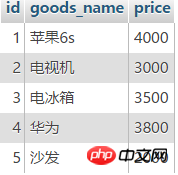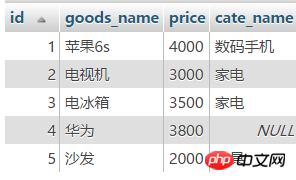
This article mainly introduces you to the relevant information about mysql's self-connection and join association. The introduction in the article is very detailed. I believe it has certain reference value for everyone. Friends who need it can come below. Let’s take a look.
1. mysql self-connection
mysql sometimes needs to connect itself (self-connection) when querying information , so we need to define an alias for the table. Let's give an example. The following is a product purchase table. We need to find all the information whose purchase price is higher than Huihui.

Generally speaking, when we see this table, we use the statement to operate it as soon as possible:
SELECT * FROM shoping WHERE price>27
As you can imagine, how simple this is, What if you don’t know the detailed data of the database table or the amount of data is quite large? As a database administrator, we must use other methods to quickly find the data we need.
Step-by-step query
The simplest way is also the easiest to think of the operation:
SELECT price FROM shopping WHERE name='惠惠' //得出price查询结果为27 SELECT * FROM shopping WHERE price>27
Compared with the self-connection method, This method requires manual intervention on intermediate results, which is obviously not conducive to automatic processing operations in the program.
Self-connection method:
SELECT b.* from shopping as a,shopping as b where a.name='惠惠' and a.price<b.price order by b.id
We can obtain the following table information:

Note:
Although aliases a and b have different names, they are the same table. The purpose of defining aliases is to make it easier to delete them.
The b.* obtained by executing select through (intermediate table) is the final result.
Subquery
Subquery is also a commonly used method, which is to nest select within select.
The implementation code is as follows:
SELECT * FROM shopping WHERE price>(select price from 'shopping' where name='惠惠')
The results are as follows. It can be seen that the results obtained by the two methods are the same:

2. JOIN
##INNER JOIN
The main function of inner association is that when there is at least one match in the table, Return the result set. The inner join and join here have the same function, so they are introduced together.The following are two tables, the goods and category tables:


##
SELECT * FROM goods INNER JOIN category ON goods.id=category.goods_id ORDER BY gods.id

JOINLEFT JOIN keyword will be selected from the left table ( table_name1) returns all rows there, even if there are no matching rows in the right table (table_name2). It is recommended to use left association when working on projects. However, there are many table relationships. One table is a left join to a, but at the same time it is a right join to b. In this case, adding a right join may be more convenient to write.
Apply the first two tables to perform left correlation query:
SELECT goods.*,category.cate_name FROM goods LEFT JOIN category ON goods.id=category.goods_id ORDER BY goods.id

##RIGHT
The RIGHT JOIN keyword will return all rows from the right table (table_name2), even if there are no matching rows in the left table (table_name1). Apply the first two tables to perform a right correlation query: The above is the detailed content of Parse mysql's self-connection and join association. For more information, please follow other related articles on the PHP Chinese website!SELECT a.goods_name,a.price,b.*
FROM goods as a
RIGHT JOIN category as b
ON a.id=b.goods_id
ORDER BY b.id




